Reviews
Tsuma yo, bara no yo ni
Mikio Naruse
Japan, 1935
Credits
Review by Ian Johnston
Posted on 28 November 2007
Source Taped TV broadcast
Categories Flowing: The Films of Mikio Naruse
There’s a real irony to the fact that Naruse, the “neglected” third master of classic Japanese cinema whose films have had such limited international exposure over the decades, is also the director of the first Japanese sound film ever to be released overseas. Wife! Be Like A Rose! appeared in a shortened version under the title Kimiko for a sadly too-brief run in New York in 1937, a release that’s famous for the negative reviews it garnered, above all from the New York Times critic Frank S. Nugent (yes, the same man who went on to write screenplays for John Ford). By all accounts the Times review killed the film’s commercial prospects, although it should be said that not all the American reviews were so hostile; in an informative piece of reception research (available in translation in Rouge) Kiyoaki Okabu has pointed in particular to poet Mark Van Doren’s sympathetic reading of the film.
This failure at the Western box office—for a film that was acknowledged in Japan as the best of its year—is an interesting aside so to speak, an augury of how long it was going to take for Western audiences to both “get” and get access to Naruse’s films, but it’s hardly central to our appreciation of the film today. Wife! Be Like A Rose! is a great film from the equally great period of Japanese cinema of the thirties (of which personally I’ve only been able to see a handful of films: all of Ozu’s, a few of Mizoguchi’s, this and another film of Naruse’s, and Sadao Yamanaka’s masterpiece Humanity and Paper Balloons—all rich films that have me hoping that somehow further chances are going to come along to explore this period). It is also quite remarkable stylistically: in comparison to the subdued, almost invisible style of Naruse’s famous films of the fifties and sixties, it’s decidedly flamboyant in its camera movement (pans and tracks in all directions) and its editing patterns.
The Kimiko of the film’s American title is Wife!’s heroine, the young daughter of estranged parents, contemplating marriage herself and intent on effecting reconciliation between her father and mother. The motivation for this is partly the sympathy she feels for the situation of her poetess mother, and partly too her own personal reasons. In order for her marriage to her fiancé Seiji to go forward, a meeting between her father and Seiji’s needs to be arranged, something of an impossibility in the current situation where Kimiko’s father Shunsaku lives in the country and rarely visits his “home” in Tokyo—and, as we soon discover, when he is in town, he will even avoid seeing his wife and daughter.
This points to the social difficulties, over and above the family/emotional ones, experienced by this household of solo mother and young working daughter. It is clear that Japanese society and customs of the day are predicated on the presence of a male as the head of the household, and the problems this poses in the arrangements for Kimiko’s marriage are repeated in the request made by a student of her mother Etsuko to act as go-between at her wedding. Once again, custom requires the presence of the husband/father, and Etsuko is in the position of being socially obligated to accede to a request she cannot in fact fulfil. It is clearly viewed as socially and morally right that Shunsaku be extricated from the clutches of the ex-geisha Oyuki with whom he is living in the countryside and that Shunsaku and Etsuko be reunited.
This is the view proposed by Etsuko’s brother Shingo, who, even if he’s played comically, offers an important counter-image to Etsuko and Shunsaku’s dysfunctional marriage. His performance of classical song is mocked by both Kimiko and the film—Naruse has “reaction” shots of a cup jumping on a table and birds twitching in their cage—but, as at other times during the film, the content of the song has a direct bearing on the film’s concerns: “I have promised to stay with you, Sawaichi […] We will be man and wife into the world beyond.” Kimiko’s aunt and uncle in addition demonstrate in mirror-image to her own parents how a stronger wife and weaker husband can accommodate themselves within a marriage.
Of course the comic tone to Shingo’s character at the same time undermines his position, and in fact Wife!’s three-part structure, moving from Tokyo, to a country village, and back to Tokyo again, represents the journey both Kimiko and the audience have to take to realise that the social norms are wrong, that here are a husband and wife who should not be reunited. This climaxes in the scene at the end of the film in which Kimiko, after having gone to such lengths to bring her father back from the countryside to their home, says simply to him: “Father, please go.”
The first part of the film contrasts the characters of Kimiko and her mother Etsuko. Kimiko is charming and vivacious, witty, down to earth, and self-aware. (No surprise that Naruse married actress Sachiko Chiba, even if, in keeping with the famed miserabilist tone of his personal life, this sole marriage ended quickly.) In this Tokyo section of the story she slips effortlessly between Western and traditional Japanese dress, at ease with both. She has a modern sensibility, best evidenced in the relationship of true equals she has with her fiancé Seiji—and what a contrast with that of her parents or her uncle and aunt! The early sequence of her and Seiji’s walk in the streets is a delight as the shifts in this walk, the separating and the running to catch up again, all mark their playacting at feigned indifference to one another. Kimiko is indeed very playful. She’s very aware of the female role that she’s expected to play, and she tells Seiji she’ll be able to play it very well, but there’s no doubt she’ll give Seiji a run for his money at the same time: when he pays a visit to her home, he’s the one that’s sent off to make tea while Kimiko continues sitting in the living room.
Kimiko’s casual good humour is the absolute opposite of her mother. Etsuko is serious-minded, formal, and refined, and there’s a sense that her poetry-writing is an emotional indulgence in her sad domestic situation. There’s even an element of conflict between mother and daughter when Etsuko asks for solemn quiet so that she may seek inspiration for her poem “With spring my solitude grips my heart more harshly than in winter” and the vivacious Kimiko can’t control herself from unthinkingly bursting into song.
There’s a comic tone to the grimly serious obsession with which Etsuko tackles her writing, the way she enters her home and without a single word of acknowledgement to guest Seiji heads straight for her study; and there’s comedy, too, in the way the subject of her poetry—“Neglected I remain these many years / Yet each spring I long for him afresh” or “Alone year after year / I’ve lost the art of joking”—is her incompatible and unrefined husband Shunsaku. Kimiko is both sympathetic to and frustrated by her mother. She’s clearly irritated and even upset by her mother’s lack of realism about her situation—the most apparent example being the way Etsuko first orders a new coat for a poetry reading and book publication party, then straightaway an expensive kimono for a wedding at which, although she’d promised, she can’t act as go-between. But Kimiko’s also sensitive to her mother’s hurt and humiliation (the audience is made private witness to this in a shot where Etsuko touches the side of her face with a hand, a gesture which recurs at the end of the film), and in fact the comic, jaunty tone to the start of the film ceases with the realisation that Shunsaku, in spite of being in Tokyo, is not going to visit them. It’s at this point that Kimiko, encouraged by her uncle who sets up Shunsaku’s “woman” as a manipulator, an ex-geisha happy to dispose of him once his money runs out, takes it upon herself to retrieve her father from the countryside in order to effect a reconciliation with her father and mother.
In contrast to the way Kimiko’s choice of dress—that is, her choice between either modern Western or traditional Japanese—is reflective of her own ease and grace, and of her ability to successfully negotiate her own path within her world, her modern office clothes are conspicuously out of place in the countryside, a sign of how she has misjudged the situation. We soon learn that Shunsaku is a struggling, ever-unsuccessful gold prospector, living an impoverished yet harmonious life with his common-law wife Oyuki and his daughter Shizue and school-age son Kenichi. This whole middle section of the film, in fact, is introduced by a charming sequence where Shizue, who seems to be of the same age as Kimiko, goes out to meet her father at his prospecting site, a sequence which underlines the warmth of feeling between father and daughter.
Oyuki proves to be anything but the gold-digging mercenary geisha of Shingo’s imagination. In fact, she is the breadwinner of the family (she runs a small hairdresser’s), even responsible for sending anonymous money orders to Etsuko that everyone has always assumed have come from Shunsaku. Later, she’s even going to use the savings she has put aside for her own daughter’s marriage to enable Shunsaku to go to Tokyo to make the arrangements for Kimiko’s wedding.
This kind of self-sacrificing woman is a familiar trope of Japanese cinema (Mizoguchi built a good part of his career on it) and it’s an image of women that modern audiences can feel uncomfortable with where they don’t simply reject it, but there’s still no question that the film views Oyuki in entirely admirable terms. At night the family are sitting together and we overhear Kenichi’s memorisation of his homework: first, a lesson in filial piety where the subject’s making of a meagre but satisfying living is a clear reflection of Shunsaku’s situation; then, a lesson on “wifely duties”, the story of a samurai’s wife who ends up working in the fields. In the later case, the contrast with Etsuko, to her disadvantage, is clear. It is in the presumably lowly-born Oyuki that the spirit of this samurai’s wife is to be found, and not in the refined and upper-class Etsuko.
The core to this middle section of the film is a lengthy and deeply-felt conversation between Oyuki and Kimiko. In this emotional exchange, overheard by an affected Shizue, Oyuki gives expression to the deep bonds that tie this family together and Kimiko, in the face of this, seemingly renounces her plan of retrieving her father. The beauty and delicacy of this scene is even greater for the way Naruse inserts cutaways to the absent father and son in the public bathhouse together and to single exterior shots of the house, and then ends it with Kimiko standing in the doorway looking out to the sound of Kenichi’s voice singing in the dark and a final shot of Shunsaku and Kenichi cheerfully coming down the alley towards the house.
Kimiko, as I say, gives up on her scheme to bring about a reunion between her father and mother, as is only appropriate given the closeness and tenderness she observes when, for example, Oyuki massages Shunsaku’s shoulders or how she helps him pack for Tokyo. In fact, it is Oyuki who insists that Shunsaku return to Tokyo to attend to his fatherly duties in relation to Kimiko’s marriage. This is in a nice scene where Shunsaku sits smiling ineffectually on the floor while Kimiko and Oyuki stand over him debating whether he should go or not. At any rate, Kimiko recognises where Shunsaku’s true place is: “You’re no good without Oyuki,” she says. “The two of you are in complete harmony. My mother can’t do that.”
This doesn’t stop Kimiko changing her mind when on their train journey together she feels a sudden onrush of affection towards her father. This scene, narrated by Kimiko in voiceover, is a good example of the formal complexity of Naruse’s work that is in evidence throughout Wife! It opens with a right track following Shunsaku along the train, moving through tilts and pans, and ending with a double reverse-track: first, out from Kimiko to bring her and her father together in the one shot, then, again out from Kimiko to bring Seiji into the shot as she brings her story to an end.
In this return to Tokyo, the comic tone of the first part of the film reappears, underlining the impossibility of a reunion between this wife and husband. Etsuko, Shunsaku, and Kimiko go out for a day together, with husband and wife forever at odds. First, there’s the comic squabbling and toing-and-froing on the street over whether to take a taxi or not. Here, Etsuko is decidedly excluded as Kimiko and Shunsaku devolve into a childish game of hitchhiking based on an American movie (It Happened One Night?) Kimiko has seen. Then, Etsuko suffers with purse-lipped disapproval through Shunsaku’s drinking in a restaurant. And finally Shunsaku literally falls asleep during a Kagamijishi Kabuki dance performance (the subject, incidentally, of a short Ozu documentary made at the same time). As Seiji says, this is a farce, but Kimiko is also right to call it a tragedy, for these two tones shift back and forth here as they do throughout the film. In the final shots of the film a more solemn tone predominates. Shunsaku has left the house without having Etsuko called from her room (we’ve just seen that beneath her calm and refined exterior she is in fact devastated), and mother and daughter are left to face one another alone. “Mother has lost,” says Kimiko, and the superimposed shots of the countryside layered over this sequence only add to the bitterness of this conclusion. Shunsaku was only right to go, but as Kimiko stands there, in this final, sombre moment of the film, she seems as forlorn and bereft as the seated, weeping Etsuko.
More Flowing: The Films of Mikio Naruse
-
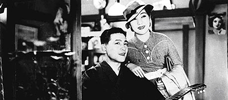
Wife! Be Like a Rose!
1935 -
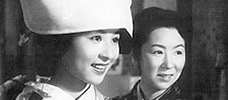
Mother
1952 -
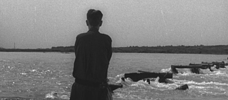
Older Brother, Younger Sister
1953 -
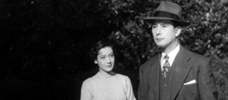
The Sound of the Mountain
1954 -

Floating Clouds
1955 -
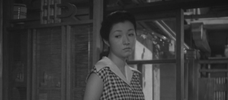
Flowing
1956 -

Summer Clouds
1958 -
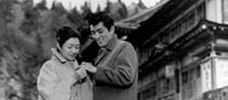
Yearning
1964 -
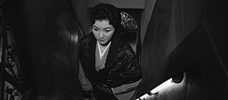
When a Woman Ascends the Stairs
1960 -
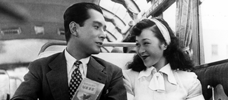
Repast
1951
We don’t do comments anymore, but you may contact us here or find us on Twitter or Facebook.



